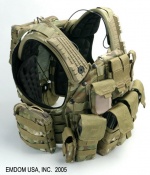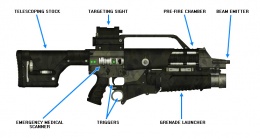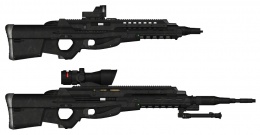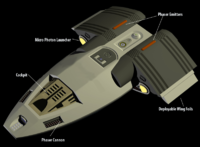Constitution Marine Equipment
| This article needs to be discussed. |
| Please enter your input on the discussion page. |
| USS Constitution-B | ||
|---|---|---|
 ACTIVE STATUS | ||
| ||
Marine Weapons and Equipment Regulations
Non-combat
A Starfleet Marine assigned to a duty post will wear their:
- Standard Duty Uniform or Search and Rescue Duty Uniform
- Type 2 Mark VII "Aquila" Sidearm
- Combat Tricorder
- Marine Combat Knife (concealed)
Combat
When involved in combat operations, a Marine will wear their:
- Standard Duty Uniform or Search and Rescue Duty Uniform
- Body Armor
- Ballistic Helmet
- Combat Tricorder
- Marine Combat Knife
- Marine Phaser Rifle
Marine Weapons and Equipment Descriptions
Type 2 Mark VII "Aquila" Pattern
An updated model of the standard Type -2 that was used throughout the early 24th Century, the Aquila pattern was designed for use by the Federation Marine Corps, Starfleet Hazard teams, and for more robust away missions. Built on the more sturdy ancient Terran design for firearms, the Aquila was designed to be more durable and further in line with the primary weapons often used by the marines. Along with these design improvements the Starfleet Corps of Engineers simplified the power scale and restructured the emitter to fire phaser pellets instead of a concentrated phaser beam. This change removed the Aquila from a ‘tool’ category and grounded it firmly as a weapon. Instead of a scaling power level from one to sixteen, which was used primarily to credit the original models as a cutting tool, the Aquila has five settings. Light Stun, Heavy Stun, Disruption, Lethal (Kill), and Disintegrate. The final setting has a limited range and spends the weapons power supply quickly. A blue digital readout on the right and left side of the weapon displays the remaining charge and current setting.
Specifications
- Beam Intensity Settings:
- Type 2 Mk VII: 1, 3, 7, 9 and 12
|
Combat Tricorder
The combat tricorder is a specialized tricorder carried by Starfleet Marines. Along with its basic tricorder functions, the combat tricorder is programmed with strategic and tactical information and countermeasures. The combat tricorder links with the Ballistic Helmet for combat operations.
Marine Combat Knife
The Marine Combat Knife is a survival and combat knife. It has a single edged twelve inch durasteel blade. The standard issue knife has a matte black finish to avoid reflection and to decrease the chances of detection.
The handle contains a small laser torch and a wire saw that can assist a Marine during wilderness survival.
Statistical Information:
Length: Blade - 12 inches / Overall - 17.25 inches
Weight: 3 pounds
Maintenance:
Minimal maintenance is required since the blade maintains its sharpness and avoids rust over long term use.
Marine Type III-C Phaser Rifle
The Marine Type III-C Phaser Rifle is a variation of the standard phaser rifle used by the Starfleet. The III-C Rifle is primarily used by Starfleet Marines.
24th century phaser rifles have sixteen power settings, fully-autonomous recharge capability, multiple-target acquisition, and gyro-stabilization.
Power levels can be changed by manipulating either manually or through the uplink to the Ballistic Helmet. Rotating the power level selector forward increases the power level setting. The rifle contains and a multi-function scope that can be retracted into the body of the weapon.
The III-C rifle is specifically reinforced to allow a Marine to use it as weapon against an assailant wielding a Bat'leth or similar weapon in close quarters without damaging the rifle. This reinforcement makes the III-C rifle a heavier weapon than similar Starfleet rifles.
Statistical Information:
Length: 76.2 centimeters / 30 inches
Weight: 4.5 kilograms or 9.9 pounds
Total energy reserve: 12x10^8 megajoules in a hot-swappable sarium-krellide power pack.
Power settings: 1-16 operable by pressing buttons on the control panel or with the Ballistic Helmet.
Firing Modes (changed with the control button on the control panel):
- Single - As with any other phaser weapon, one shot per pull of the trigger.
- Sustained - A sustained beam or stream, which is useful for cutting through obstacles or wearing down force fields or the target's resistance. Activated by holding the trigger down.
- Burst - Capable of firing up to twenty-five pulses of energy within a second. Burst fire coils store energy in a similar way as the phaser cannon charging all the coils with the energy for the imminent firing. The coils cannot hold the energy for long, and the energy is allowed to dissipate out of the coils to avoid an overload. This reduces the life span of the power pack by approximately 50% and causes the coils to visibly glow, emanate heat, and emit sound at 45 decibels, which limits its use in many combat situations. There is a delay of 0.02 second between pulses allowing the user to engage multiple targets.
- Random - The III-C Phaser Rifle comes with integral frequency variation circuitry.
Maintenance:
The weapon's frame is cast into its shape and is thus nearly invulnerable to any bending or damage without using power tools, which is similar to the II-D sidearm that was the basis for the rifle. The weapon cannot be dismantled without first removing the power pack to avoid any accidents.
The emitter crystal is grown into the frame to eliminate any possible misalignment due to rough treatment, and the circuitry is located around the frame allowing the frame to be removed by opening the front of the weapon and pulling it out for maintenance. Other circuitry frames are located in two casings on each side of the frame to facilitate fast repair and easy access.
Structure:
- Beam control assembly
- Discharge crystal
- Emission aperture
- Energy cell
- Power pack
- Prefire chamber
- Rapid nadion pulse
- Safety interlock
- Sight
TR-116 Rifle
The TR-116 Rifle is a hand-held rifle that delivers a lethal projectile for use in dampening fields or radiogenic environments where conventional energy weapons are useless. The rifle fires a chemically propelled tritanium bullet.
The rifle can be modified to use a micro-transporter to beam the projectile into a nearby room at lethal velocity at the time the trigger is pulled. Targeting for the rifle is made through the Combat Tricorder and/or Ballistic Helmet visor under these circumstances.
Due to the power expenditure and the rare use of this weapon, only 2 TR-116 Rifles are stored in the Marine armory for use by the Marine snipers ONLY.
Pulse Rifle
Used since the 22nd century, the pulse rifle uses a combination of kinetic energy and temperature control of a plasma bullet. The mechanism uses a plasma generator that uses a microcontroler for the temperature and a chamber that charges the projectile with kinetic energy that is liberated at a maximum rate of up to fourteen discharges a second. The maximum capacity of the energy cell is between one hundred and one hundred twenty projectiles depending on the version of the weapon.
SAR Gear
- Tricorders and PADDs – medical and standard.
- First aid kits and equipment such as dermal regenerators, bone knitters, pain killers and other drugs and equipment needed to adequately treat patients at the scene.
- Flashlights, power packs, grappling gear, heavy duty wiring and ropes, survival packs (and rations), heavy cutting gear, harnesses, underwater breathing apparatus, spades and pickaxes, flares, pattern enhancers.
ISARAS
The Integrated Search and Rescue Armour System (ISARAS) is a modular armoured vest system based on the Crye and CIRAS systems of 21st century Earth, designed specifically for the varied duty requirements of the SAR Team. The vest itself provides superior protection from physical attack as well as substantial protection from most energy-based weapons fire.
The ISARAS can be fitted with numerous pouches and clips and customized to the individual wearer and their role on the SAR Team. For example, an engineer may have -- in addition to the phaser holster standard on all configurations -- a tricorder pouch and various tool and equipment pouches/clips, while a medical officer would carry advanced medkits, hyposprays, etc. A marine participant may have the majority of their ISARAS dedicated to carrying weaponry and explosives, depending on the role the individual has been asked to fill.
Type 33 CQC
The Type 33 Close Quarters Combat Phaser Rifle is the newest addition to the Starfleet armoury. Production began in early 2388 in response to problems and concerns raised by Starfleet officers participating in the retaking of space station Deep Space 17 during the Second Battle of Eratis. The Type 33 CQC's compact design is intended to make operating in confined spaces, such as the corridors and jeffries tubes of DS17, far easier. Total length of the Type 33 CQC is 688mm (27.08 inches) and its weight is 2.54 kg (5.6 lbs).
The type 33 is the primary rifle of choice for standard SAR operations going forward, due to their small, lightweight design.
Type 28
Initially designed as a special operations rifle for the Starfleet Marines, the Type 28 was quickly adopted as a useful mid-level workhorse rifle for Search and Rescue. Though not as compact as the Type 33, the 28's modular nature makes it a very useful tool -- the targeting sight can be swapped out for several different types of sight and the folding fore-grip can also be removed and replaced with a flashlight, scanner or one of several other types of tool.
Type 204 SOSAR
The Type 204 SOSAR (Special Operations - Search And Rescue) has the distinction of being the only phaser designed specifically for Starfleet Search and Rescue. Based loosely on the Type 200 rifle -- which is still used by some marine contingents -- the 204 SOSAR includes many improvements, including an adjustable telescoping stock, a rail system to allow the attachment of various scanning and infrared tools, an extremely durable plasteel body and the standard attachment of a grenade launcher (primarily for using "flash-bang" grenades).
The SOSAR is clearly a rifle used in more hostile situations, where it is known ahead of time that a SAR Team will face serious opposition to their goals from well-armed adversaries.
Type 32 and 32A OSR
A rather larger rifle, the Type 32's base design was adapted to become the Type 33 CQC. A workhorse rifle, the 32 is still used in many combat situations, primarily by Starfleet Marines, but also in some situations by Starfleet Security. Many prefer it's more ergonomic design to that of the SOSAR. It's length makes the 32 generally ill-suited to SAR operations, but it's Operational Support Rifle variant -- the Type 32A OSR -- has become standard equipment in any Search and Rescue department. Essentially a sniper rifle, the 32A goes by the much less militaristic sounding name of "Operational Support Rifle." The 32A OSR shares the same body as the Type 32, with a longer barrel, more advanced and higher quality targeting sight and a folding bipod. The purpose of the OSR is to provide support for evacuations and protection for SAR Team members performing their duties in hostile environments.
Marine Uniforms
Uniforms
Search & Rescue Duty Uniform (SDU)
In certain circumstances, wearing a standard Starfleet duty inform is not practical. In such instances, SAR Teams can choose to wear a specially-designed duty uniform known as the SDU. The SDU is made of a lightweight, but extraordinarily durable synthetic fibre that is highly resistant to heat, cold and tearing. The SDU is also a temperature-regulating fabric, allowing its wearing to better adapt to extreme temperatures and/or rapid change in temperature.
Shown at right is the Marine version of the SDU. While deployed on a SAR Team, a participant would wear an SDU in the appropriate department colour.
Marine Standard Duty Uniform & Standard Enlisted Uniform
Normaly on a starbase or a starship marine members can be found wareing these uniform.
Combat Uniform
If marines are onboard a ship or base that gose to condition yellow or if they are needed on a mission they can normal be found waring there combat uniform.
Armour
Personal protection for a Marine in combat operations is essential. Marine Body Armor is designed to provide a balance between protection and weight. The body armor is separated into upper body and lower body protective gear. The Marine Body Armor consists of the same CADM (Crystalline Ablative Dispersal Matrix) that is utilized in the Marine Ballistic Helmet. The protective vest contains remote biomonitors, which measure the wearer’s health, and a personal transport inhibitor designed to prevent enemies from using transporters against Marine units.
Helmet
Constructed with a hardened ballistic plastic, the CADM (Crystalline Ablative Dispersal Matrix) Ballistic Helmet is fitted with a retractable visor for a full seal. The helmet contains an advanced multi-function communications system. Operated by pupil tracking and a verbal short hand, the Ballistic Helmet allows a Marine hands-free operation of the unit while concentrating on fighting and other attention-intensive tasks.
The helmet's multi-function communications system can send the Marine's coordinates to units nearby, perform mapping and navigation functions, and project command and mission data on the visor. It also includes a helmet-to-helmet infrared communications link, allowing discrete, short distance communications between individual Marines while lessening the chances of interception, communications signal encryption, as well incorporating standard combadge traffic.
The Ballistic Helmet's visor also operates as a data screen for the user's Combat Tricorder and other linked or integrated systems. The visor's systems open programming structure allows it to accept multiple signals and upgrades in the field. It also features a three hundred sixty degrees proximity and target/threat tracking display, low light vision enhancement with rapid polarization, and audio enhancement/suppression to prevent disorientation.
Sensory enhancements and protections can be modified to accommodate different species' sensory requirements; although after a certain point of acuity, the helmet is configured to allow a Marine's senses to work without the helmet's interference.
Each Marine's helmet is equipped and programmed to assist them in tasks specific to their position and MOS such as target designation, range finding, and chemical analysis. Officers and NCOs get units with more processing power and a broader range of capabilities and command functions, including signal interception, analytical functions, and troop status readouts.
The helmet can be modified to fit the ergonomic, mission, and, to a limited extent, the aesthetic needs of the individual Marine.
Field Structures
Marine Craft & Vehicles
Lancer-Class Multirole Fighters
INFO
| Image | Specs |
|---|---|
|
Dragoon-Class SAR Transports
INFO
| Image | Specs |
|---|---|
|
Paladin-Class Ground Combat Vehicle (GCV)
INFO
| Image | Specs |
|---|---|
|












































